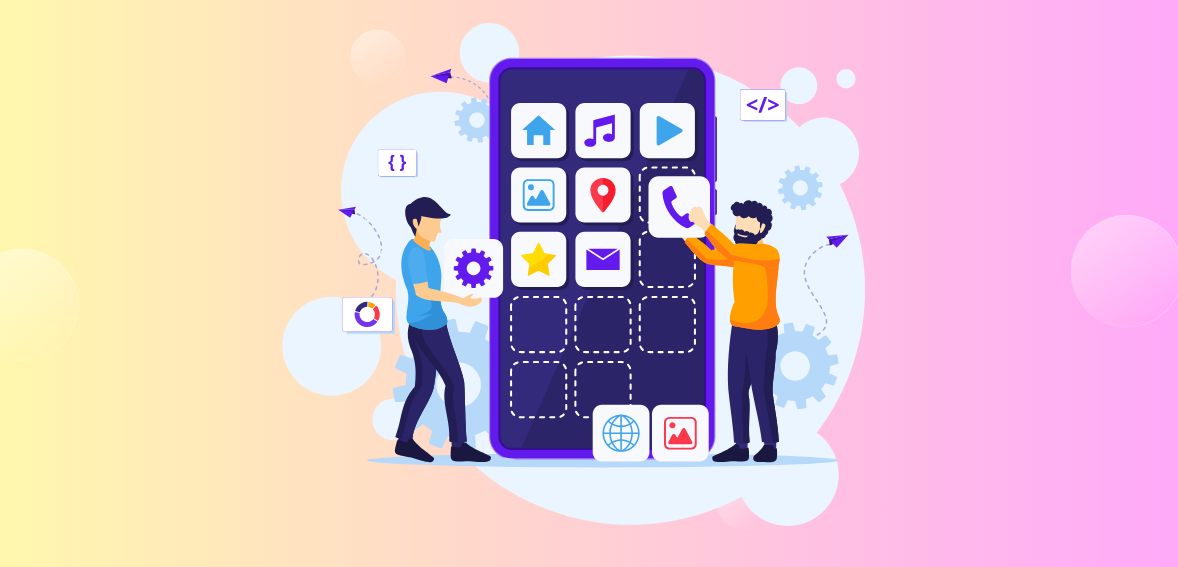Cross-platform development has gained significant traction as businesses strive to reach wider audiences across multiple platforms without incurring the high costs and extended timelines associated with developing native applications for each operating system. In 2024, this trend continues to soar, driven by the need for efficient, scalable, and cost-effective solutions. Among the tools enabling this transformation, Flutter and React Native are at the forefront, offering robust frameworks that simplify the development process. But how do these two compare, and which one should you choose for your project?
The State of Cross-Platform Development in 2024
The year 2024 has seen a remarkable rise in the adoption of cross-platform development frameworks, with a clear shift towards more versatile and flexible development environments. Market trends indicate a growing preference for frameworks that allow developers to write code once and deploy it across multiple platforms, including iOS, Android, web, and desktop. This approach not only reduces development time and costs but also ensures a consistent user experience across different devices.
Developers are increasingly favoring frameworks that offer rich libraries, strong community support, and continuous updates. Businesses, on the other hand, are looking for solutions that can deliver high performance, seamless user interfaces, and the ability to scale with future demands. In this context, both Flutter and React Native have carved out substantial niches, each offering unique advantages.
What is Flutter?
Flutter, developed by Google, is an open-source UI software development kit (SDK) that enables developers to create natively compiled applications for mobile, web, and desktop from a single codebase. Launched in 2017, Flutter has quickly gained popularity due to its powerful features and capabilities.
Key Features of Flutter
- Dart Programming Language: Flutter uses Dart, which is known for its fast performance and ease of learning.
- Hot Reload: This feature allows developers to see the results of code changes almost instantly, enhancing productivity.
- Rich Set of Widgets: Flutter provides a comprehensive collection of customizable widgets that enable high-quality, responsive UI designs.
- Single Codebase: Developers can write one codebase and deploy it across multiple platforms, ensuring consistency and reducing development time.
- Strong Performance: With its native compilation, Flutter offers near-native performance, making it suitable for performance-intensive applications.
Pros and Cons of Flutter
Pros:
- Excellent performance due to native compilation.
- Extensive and customizable widget library.
- Strong community support and extensive documentation.
- Fast development cycles with Hot Reload.
Cons:
- Relatively new, so fewer third-party libraries compared to more established frameworks.
- Larger app size due to the inclusion of the Flutter engine.
- Dart is less popular than JavaScript, leading to a smaller talent pool.
What is React Native?
React Native, developed by Facebook, is an open-source framework that enables developers to build mobile applications using JavaScript and React. Since its release in 2015, React Native has been widely adopted for its efficiency and flexibility.
Key Features of React Native
- JavaScript and React: Utilizes the popular JavaScript language and React library, making it accessible to a large pool of developers.
- Fast Refresh: Similar to Flutter’s Hot Reload, Fast Refresh allows for quick iteration cycles by enabling instant updates to the application during development.
- Native Components: React Native allows the use of native components, which enhances performance and provides a more native look and feel.
- Large Ecosystem: A vast collection of third-party libraries and tools supports React Native, extending its capabilities and simplifying development.
Pros and Cons of React Native
Pros:
- Extensive use of JavaScript, making it accessible to many developers.
- Large and active community with abundant resources and libraries.
- Efficient development with Fast Refresh and reusable components.
- Strong performance with native modules.
Cons:
- Performance may not match that of fully native apps in complex scenarios.
- Fragmentation issues with different versions and dependencies.
- Requires bridging for certain native functionalities, which can complicate development.
Flutter vs. React Native: A Comparative Analysis
When it comes to choosing between Flutter and React Native, several factors come into play, including performance, development speed, UI/UX capabilities, community support, and the learning curve. Each framework has its strengths and is suited to different types of projects and developer preferences.
Performance Comparison
Performance is a critical consideration in cross-platform development. Flutter, with its native compilation and use of the Dart language, offers near-native performance, which is particularly beneficial for performance-intensive applications. React Native, while also performant, relies on a bridge between JavaScript and native components, which can sometimes lead to performance bottlenecks.
In terms of speed and efficiency, Flutter often has the edge due to its direct compilation to native ARM code, bypassing the need for a JavaScript bridge. This allows for smoother animations and faster load times. However, React Native’s performance can be optimized with careful coding practices and the use of native modules.
Development Speed and Productivity
Both Flutter and React Native excel in improving development speed and productivity. Flutter’s Hot Reload and React Native’s Fast Refresh allow developers to see the effects of their changes almost instantly, significantly reducing development cycles. Additionally, both frameworks support a high degree of code reusability, which is a key advantage in cross-platform development.
Flutter’s extensive widget library and customizable UI components facilitate rapid prototyping and development, while React Native’s large ecosystem of third-party libraries provides developers with a wide range of tools to enhance their productivity. Ultimately, the choice between the two may come down to specific project requirements and developer familiarity with Dart or JavaScript.
UI/UX Design Capabilities
Creating a consistent and visually appealing user interface is crucial for any application. Flutter shines in this area with its rich set of customizable widgets and a highly responsive design framework. The ability to create intricate animations and complex UIs with ease makes Flutter a favorite among developers focused on delivering a top-notch user experience.
React Native also offers robust UI/UX design capabilities, leveraging native components to provide a more authentic look and feel. However, achieving the same level of customizability and performance as Flutter might require additional effort and the use of third-party libraries.
Community Support and Ecosystem
Community support is vital for the ongoing success and improvement of any development framework. React Native benefits from a large and active community, given its longer presence in the market and its foundation in JavaScript and React, both of which have massive followings. This extensive community contributes a wealth of libraries, tools, and resources that enhance the development experience.
Flutter, while newer, has rapidly built a strong community and ecosystem, thanks in part to Google’s backing. The extensive documentation, combined with a growing number of third-party libraries and tools, makes it a formidable contender in the cross-platform development space.
Learning Curve and Developer Experience
The learning curve can significantly impact a developer’s decision to adopt a particular framework. React Native’s use of JavaScript and React makes it relatively easy for web developers to transition to mobile app development, given the widespread knowledge and use of these technologies.
Flutter, on the other hand, requires developers to learn Dart, a language that, while powerful and easy to pick up, is not as widely known as JavaScript. However, many developers find Flutter’s consistent and cohesive framework, combined with its comprehensive documentation, to be conducive to a smooth learning experience.
Case Studies: Successful Apps Built with Flutter
Flutter’s growing popularity is reflected in the number of high-profile applications developed using the framework. Examples include Google Ads, Alibaba, and Reflectly. These apps demonstrate Flutter’s capabilities in delivering high-performance, visually stunning applications that scale effectively. Businesses report significant improvements in development speed and cost savings, alongside positive user feedback highlighting smooth performance and appealing UIs.
Case Studies: Successful Apps Built with React Native
React Native boasts an impressive list of successful applications, including Facebook, Instagram, and Airbnb. These apps highlight React Native’s strength in handling complex functionalities and delivering a near-native user experience. Companies appreciate the efficiency and flexibility that React Native provides, enabling them to maintain a single codebase while reaching a broad audience. User feedback often points to seamless performance and intuitive interfaces as key benefits.
Cost Considerations in Cross-Platform Development
Cost is a crucial factor in any development project. Both Flutter and React Native offer significant cost savings compared to developing separate native applications for each platform. The ability to maintain a single codebase reduces development and maintenance costs, allowing businesses to allocate resources more efficiently.
However, the choice between Flutter and React Native may affect costs in other ways. Flutter’s strong performance and customizable widgets can reduce the need for third-party services, while React Native’s extensive library ecosystem might necessitate additional investment in third-party tools and bridging components for native functionalities.
Scalability and Future-Proofing Your App
Scalability and the ability to adapt to future technological advancements are essential considerations for any application. Both Flutter and React Native are designed to scale effectively, with robust frameworks that support a wide range of functionalities and integrations.
Flutter’s native compilation and Google’s active support ensure it remains at the cutting edge of performance and feature updates. React Native, with its large community and continuous contributions, also promises longevity and adaptability. Developers should consider the long-term viability of each framework, including the frequency and scope of updates, to ensure their application remains relevant and competitive.
Security Aspects in Cross-Platform Development
Security is paramount in application development, and both Flutter and React Native offer robust security features. Common security issues include data breaches, code injection, and unauthorized access. Best practices such as regular updates, secure coding practices, and thorough testing are essential to mitigate these risks.
Flutter’s architecture inherently supports secure development practices, while React Native’s use of JavaScript necessitates additional precautions to prevent vulnerabilities. Both frameworks provide resources and tools to enhance security, but developers must stay vigilant and informed about potential threats.
Integrating with Backend Services
Seamless integration with backend services is crucial for the functionality of any application. Both Flutter and React Native excel in this area, offering robust APIs and data management tools. Real-time updates, essential for dynamic applications, are well-supported by both frameworks.
Flutter’s native performance and Dart’s asynchronous capabilities make it highly efficient for backend integrations, while React Native’s extensive library support simplifies the integration process. Compatibility with various backend services, including Firebase, AWS, and custom APIs, ensures that developers can build comprehensive and responsive applications.
Testing and Debugging in Flutter
Testing and debugging are integral parts of the development process. Flutter offers a range of tools and techniques to streamline these tasks, including a comprehensive suite of testing features for unit, widget, and integration testing. Common challenges such as UI inconsistencies and performance issues can be effectively addressed using Flutter’s robust debugging tools.
Testing and Debugging in React Native
React Native also provides a wealth of tools for testing and debugging, leveraging the extensive JavaScript ecosystem. Tools like Jest for unit testing and Detox for end-to-end testing are widely used. Common challenges include managing dependencies and ensuring compatibility across different devices, but the active community and wealth of resources help developers navigate these issues effectively.
Choosing the Right Framework for Your Project
The decision between Flutter and React Native ultimately depends on the specific requirements of your project. Factors to consider include the complexity of the application, the desired performance and UI/UX quality, the development team’s expertise, and long-term goals.
For performance-intensive applications with intricate UIs, Flutter may be the better choice. Its strong performance, rich widget library, and cohesive framework offer significant advantages. For projects that prioritize rapid development and have a team well-versed in JavaScript and React, React Native’s extensive ecosystem and community support might be more suitable.
Future Trends in Cross-Platform Development
Looking ahead, several trends are likely to shape the future of cross-platform development. Emerging technologies such as augmented reality (AR), virtual reality (VR), and the Internet of Things (IoT) will demand even more versatile and powerful frameworks. Both Flutter and React Native are poised to evolve in response to these trends, with continuous updates and new features to support advanced functionalities.
Predictions for Flutter and React Native suggest continued growth and innovation, with both frameworks enhancing their capabilities to meet the demands of future applications. Industry shifts towards more integrated and seamless user experiences will drive further advancements in cross-platform development.
Conclusion
In summary, both Flutter and React Native offer powerful solutions for cross-platform development, each with its unique strengths and challenges. Flutter excels in performance and UI customization, while React Native offers flexibility and a vast ecosystem. By carefully considering your project’s requirements, development team’s expertise, and long-term goals, you can choose the framework that best aligns with your needs.
FAQs
What are the main differences between Flutter and React Native?
Flutter and React Native differ primarily in their architecture and the languages they use. Flutter, developed by Google, uses Dart as its programming language and offers a comprehensive set of customizable widgets for building UI. It compiles to native ARM code, providing high performance and smooth animations. React Native, developed by Facebook, uses JavaScript and React. It leverages native components, offering a more native look and feel but relies on a bridge between JavaScript and native code, which can sometimes lead to performance bottlenecks.
How does the performance of Flutter compare to React Native?
Flutter generally has an edge in performance due to its native compilation to ARM code, which bypasses the need for a JavaScript bridge. This results in smoother animations and faster load times, making Flutter ideal for performance-intensive applications. React Native, while also performant, may face challenges in complex scenarios where the JavaScript bridge can become a bottleneck. However, with careful optimization and the use of native modules, React Native can achieve near-native performance.
Is it easier to learn Flutter or React Native for a beginner?
For beginners, the ease of learning can depend on their prior experience. If a developer is already familiar with JavaScript and React, transitioning to React Native will be relatively straightforward. React Native’s use of popular web technologies makes it accessible to a large pool of developers. On the other hand, Flutter requires learning Dart, which, while powerful and easy to pick up, may be less familiar to many developers. However, Flutter’s cohesive framework and comprehensive documentation can make the learning process smooth for new developers.
What are the cost implications of using Flutter vs. React Native?
Both Flutter and React Native offer significant cost savings compared to developing separate native applications for each platform, as they allow for a single codebase. Flutter’s native performance and rich widget library can reduce the need for third-party services, potentially lowering costs. React Native’s extensive library ecosystem might require additional investment in third-party tools and bridging components for certain native functionalities. Overall, both frameworks can reduce development and maintenance costs, but the specific cost implications will depend on the project’s requirements and complexity.
Which framework offers better community support and resources?
React Native, having been around longer and built on the widely-used JavaScript and React technologies, has a larger and more active community. This results in a wealth of libraries, tools, and resources available to developers. Flutter, although newer, has rapidly built a strong community, supported by Google. Its extensive documentation and growing number of third-party libraries and tools make it a robust option as well. Both frameworks offer excellent community support, but React Native’s larger community provides a slight edge in terms of available resources.
Can I integrate both Flutter and React Native with my existing backend services?
Yes, both Flutter and React Native offer robust capabilities for integrating with backend services. They support various backend solutions, including REST APIs, Firebase, GraphQL, and other custom backend services. Flutter’s Dart language and its asynchronous programming features make it highly efficient for backend integrations. React Native’s extensive JavaScript ecosystem and third-party library support simplify the process of connecting to backend services. Both frameworks are well-suited for building comprehensive and responsive applications with seamless backend integration.




